September/October 2020
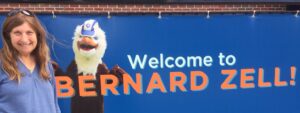
September is a month of new beginnings, when kids start school and the Jewish New Year begins—but this school year is unlike any other, with almost everyone doing almost everything VIRTUALLY, including going to school. Yet, there is an exception in Chicago, and I’d like to describe what’s happening there, since I’ve been privileged to be teaching there these last few weeks of September and now into October.
Bernard Zell Anshe Emet Day School in urban Chicago is a multi-denominational Jewish school that is celebrating its 75th anniversary this year—the oldest school of its kind in the United States. It is well staffed, well respected and well-run.
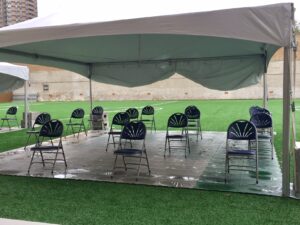
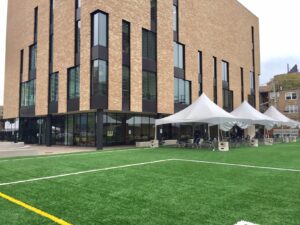
Socially distanced chairs ready for students
I was invited to be their Scholar-in- Residence for a year long Photography project. This project was created, conceptualized and organized by History teacher, Dr. Jeff Ellison, whom I met decades ago in Jerusalem when we both presented papers at a prestigious conference at Yad Vashem.
Although most of my classes this year will be, of necessity, taught virtually on Zoom, we felt it would be a great advantage for me to start working with the kids in person. And thanks to the grit, creativity, and determination of the school’s administration (Head of School, Gary Weisserman, Head of Middle School, Stephanie Bloom, and Chief Advancement Officer, Marna Goldwin) and of course, History teacher, Dr. Jeff Ellison, they found a way for me to begin teaching in person (9 classes—3 for each section). It was so great to meet the students in person, to forge relationships with them directly, and to start this year-long project with our face to face interactions (It’s actually more accurate to say, ‘mask to mask interactions’) before we started zooming the subsequent classes.
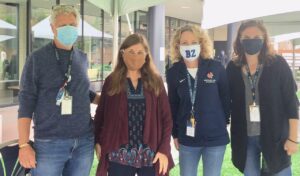
Left to right: Jeff Ellison, Ann Weiss, Marna Goldwin and Stephanie Bloom
Our year long project revolves around Photography—both general photographic principles, where I teach the students how to analyze and interpret photos. In our first class, I described my own work and the precious personal photos found at Auschwitz-Birkenau, carried by Jews, who believed they were going to be worked, not murdered. I was able to share the discovery of how these photos were found, how they were saved—thanks to a leader of the Jewish Underground at Auschwitz-Birkenau, who said “If we can’t save the people, let us at least save their memories!”—concluded the lesson with how we might view them now.
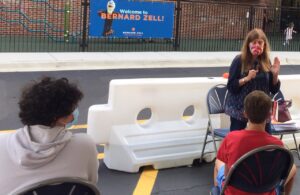
A newly purchased microphone made it possible for the students to hear Ann’s voice, behind the mask.
Our second class involved specific stories of specific people in specific photos. In addition to information about individuals in the photos, I felt that—because of this ‘needle in the haystack’ kind of research— it was also important to explain how these improbable identifications were made. I chose to focus on three stories in particular: 1-Architect Benjamin Hirsch, who accidentally saw the last photo of his brother and sister when I spoke at a conference, and screened my film; 2-Nahum Gitler and Tova Stawski, who went to pre-state Israel/Palestine as teenagers in 1934 to build a homeland (and also one of Israel’s first kibbutzim, Dagania); and 3-Dr. and Mrs. Taranszewski, who could have no children of their own, but nevertheless managed to create a ‘family’ for the children of the Bendin Orphanage, whom they visited nearly every day.
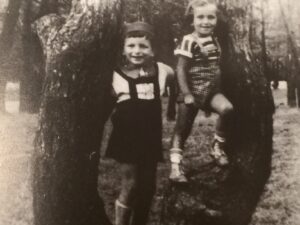
Last photo of Roselena and Werner Hirsch
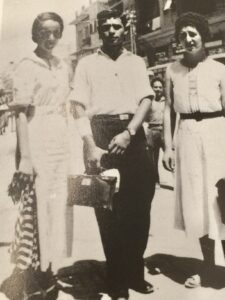
Nachum Gitler and his wife Towa Stawski (on left) with a friend in Tel Aviv, 1937
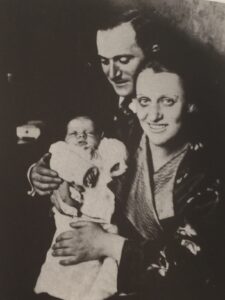
Dr. and Mrs. Taranszewski with a baby he had delivered, little Abraham Malach
In our last in-person class, the students were introduced to a formal History of Photography, so that they might understand the context for modern photography and exactly where the photos from Auschwitz fit into the historical timeline. By the end of this third class, we started to analyze specific photos. Was this taken by a professional photographer or a skillful (or not so skillful) amateur? What is happening in the photo? What cues can you find about relationships in the photograph? We will continue this process in October, as I continue to teach them more cues into ‘reading’ (analyzing) photographs.
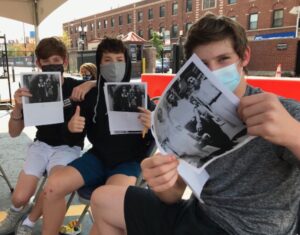
Students with their photo pack, featuring Hirsch and Gitler Families
I’d like to close with a story that touched me very deeply. I had finished explaining to the class what Auschwitz was like when I first entered in 1986, and the kinds of heartbreaking items they displayed (floor-to-ceiling shoes from the last few days of killing, mounds of ashen hair, piles of simple gold wedding rings, mountains of prosthetic limbs, and even tiny babies booties). Then I explained what happened when I got lost from my group and was alone in a locked Auschwitz: an employee found me frantically running, looking for anyone alive, and beckoned me closer with a wagging finger and these few words, “Do you want to see what’s in this room?”—and that’s how I first saw these remarkable photos, hidden in a locked room, unknown to the world for decades.
When I asked the students questions about the photos, I got many good answers. “Why do you think the Nazis destroy all the personal photos that Jews brought with them?” Some answered, “to erase their memories;” others said “to forget the people and the life they once lived”—both were good answers. The students eventually hit the primary reason: “to get rid of pictures that showed Jews were not subhuman”—the way the Nazis were telling their people.
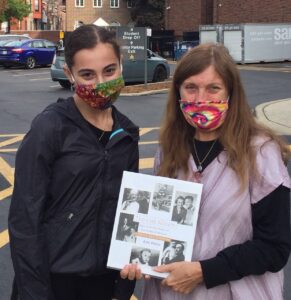
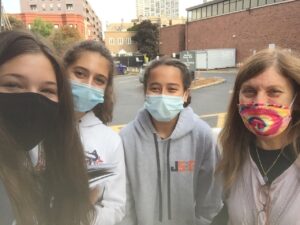
Ann saying goodbye to the students
Finally I asked, “Why do you suppose that the Auschwitz employee unlocked the door and showed me the secret cache of photos?” Again, the students offered many good answers but there was one response that, in the more than 30 years I’ve been talking about these photos, I’ve never heard one as sweet as this one:
A student in the last row, Benjamin, raised his hand and said: “So you would feel better after the terrible things you saw at Auschwitz.” Amazing.
Teaching these students at the Bernard Zell School has been so exciting. They are enthusiastic, totally engaged and display creative thinking in almost every interaction. Over the course of this school year, we’ll work on a number of photography projects—including teaching the students, together with their art teacher, Gili Sherman, how to take photos and create their own photo exhibition.
In the months to come, I’ll write more about our progress, but for now—since this is the end of my in-person classes—I’ll close by simply saying what a great privilege it is for me to teach these kids, and how stimulating it has been to share ideas with their teachers and to experience, first hand, the caring environment of this school.
When people care, it truly shows—and it has an impact on how a child grows, how a child learns and how a child comes to think about themselves. I only wish that every child in every school in the country (and throughout the world) could have access to the kind of attention and high quality education that the students at the Zell School are getting! What a world THAT would be!!
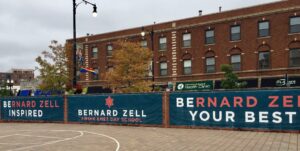
Posted in From Ann | No Comments »